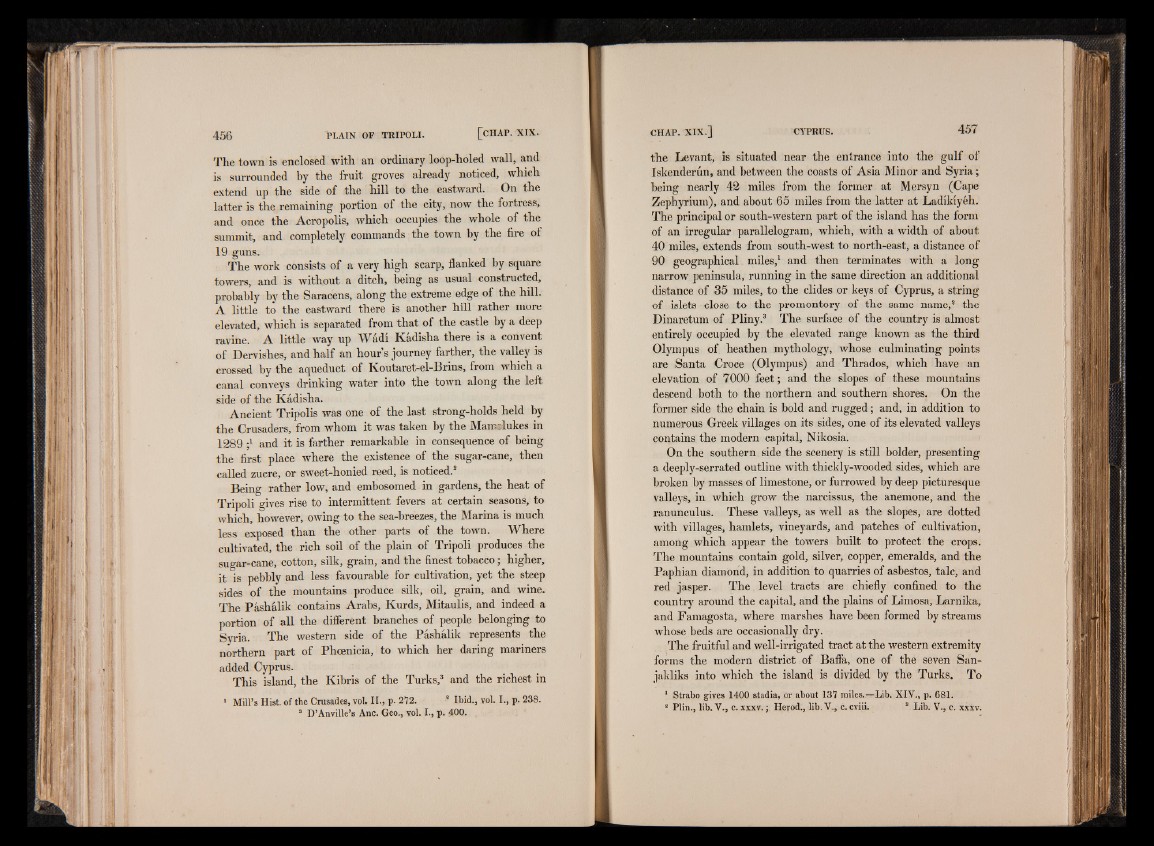
The town is enclosed with an ordinary loop-holed wall, and
is surrounded by the fruit groves already noticed, which
extend up the side of the hill to the eastward. On the
latter is the remaining portion of the city, now the fortress,
and once the Acropolis, which occupies the whole of the
summit, and completely commands the town by the fire of
19 guns.
The work consists of a very high scarp, flanked by square
towers, and is without a ditch, being as usual constructed,
probably by the Saracens, along the extreme edge of the hill.
A little to the eastward there is another hill rather more
elevated, which is separated from that of the castle by a deep
ravine. A little way up \Yradi Kadisha there is a convent
of Dervishes, and half an hour’s journey farther, the valley is
crossed by the aqueduct of Koutaret-el-Brins, from which a
canal conveys drinking water into the town along the left
side of the Kadisha.
Ancient Tripolis was one of the last strong-holds held by
the Crusaders, from whom it was taken by the Mamslukes in
1289 and it is farther remarkable in consequence of being
the first place where the existence of the sugar-cane, then
called zucre, or sweet-honied reed, is noticed.2
Being rather low, and embosomed in gardens, the heat of
Tripoli gives rise to intermittent fevers at certain seasons, to
which, however, owing to the sea-breezes, the Marina is much
less exposed than the other parts of the town. Where
cultivated, the rich soil of the plain of Tripoli produces the
sugar-cane, cotton, silk, grain, and the finest tobacco, higher,
it is pebbly and less favourable for cultivation, yet the steep
sides of the mountains produce silk, oil, grain, and wine.
The Pashalik contains Arabs, Kurds, Mitaulis, and indeed a
portion of all the different branches of people belonging to
Syria. The western side of the Pashalik represents the
northern part of Phoenicia, to which her daring mariners
added Cyprus.
This island, the Kibris of the Turks,3 and the richest in
1 Mill’s Hist, of the Crusades, vol, II., p. 212. 8 Ibid., vol. I., p. 238.
8 D’Anville’s Anc. Geo., vol. I., p. 400.
the Levant, is situated near the entrance into the gulf of
Iskenderun, and between the coasts of Asia Minor and Syria;
being nearly 42 miles from the former at Mersyn (Cape
Zephyrium), and about 65 miles from the latter at Ladikiyeh.
The principal or south-western part of the island has the form
of an irregular parallelogram, which, with a width of about
40 miles, extends from south-west to north-east, a distance of
90 geographical miles,1 and then terminates with a long
narrow peninsula, running in the same direction an additional
distance of 35 miles, to the elides or keys of Cyprus, a string
of islets close to the promontory of the same name,2 the
Dinaretum of Pliny.3 The surface of the country is almost
entirely occupied by the elevated range known as the third
Olympus of heathen mythology, whose culminating points
are Santa Croce (Olympus) and Thrados, which have an
elevation of 7000 feet; and the slopes of these mountains
descend both to the northern and southern shores. On the
former side the chain is bold and rugged; and, in addition to
numerous Greek villages on its sides, one of its elevated valleys
contains the modern capital, Nikosia.
On the southern side the scenery is still bolder, presenting
a deeply-serrated outline with thickly-wooded sides, which are
broken by masses of limestone, or furrowed by deep picturesque
valleys, in which grow the narcissus, the anemone, and the
ranunculus. These valleys, as well as the slopes, are dotted
with villages, hamlets, vineyards, and patches of cultivation,
among which appear the towers built to protect the crops.
The mountains contain gold, silver, copper, emeralds, and the
Paphian diamond, in addition to quarries of asbestos, talc, and
red jasper. The level tracts are chiefly confined to the
country around the capital, and the plains of Limosa, Larnika,
and Famagosta, where marshes have been formed by streams
whose beds are occasionally dry.
The fruitful and well-irrigated tract at the western extremity
forms the modern district of Baffa, one of the seven San-
jakliks into which the island is divided by the Turks. To
1 Strabo gives 1400 stadia, or about 137 miles.—Lib. XIV., p. 681.
8 Plin., lib. V., c. xxxv.; Herod., lib. V., c. cviii. 8 Lib. V., e. xxxv.